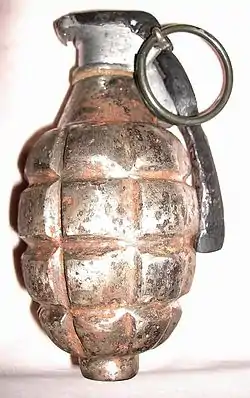Mk 1 grenade
The Mk 1 grenade (sometimes spelled Mk I) is a fragmentation hand grenade used by American forces during World War I. According to its designers, it was to be the "simplest", yet most "fool-proof", grenade ever made.[1] However, some major problems appeared when the grenade was used in the field, and it was retired from service before the war ended.
| Mk 1 grenade | |
|---|---|
 The Mk 1 grenade | |
| Type | Time-fused grenade |
| Place of origin | United States |
| Service history | |
| In service | 1917–1918 |
| Used by | United States |
| Wars | World War I |
| Production history | |
| Designed | 1917 |
| Produced | 1917–1918 |
| Specifications | |
Detonation mechanism | Timed friction fuse |
Overview
The MK 1 is a time-fused fragmentation grenade and has 32 serrations on it. To start the fuse, the user has to pull the safety pin, then push off the cap on top of the grenade. Right before throwing, the user has to move the switch on the lever away from the grenade in order to start the fuse.
Historical information
When American forces entered World War I, they lacked a fragmentation grenade of their own. American forces often received either the Mills bomb or the French F1 grenade.[2] When it came time to make a grenade, American designers looked to the F1 grenade for inspiration. In 1917, the Mk 1 grenade was created.
However, it became apparent that the Mk 1 grenade was quite difficult to use in the field. The grenades were often not ignited properly before being thrown, and enemies would return the grenade, this time properly lit.[3] The MK 1 was immediately recalled and production stopped.
Variants
Mk. IA1
The Mk. IA1 was an inert cast-iron training grenade. It has a simulated fuze with a removable pin and safety lever. They were manufactured for a brief time during World War I to train troops on how to initiate and throw the Mk. I and Mk. II fragmentation grenades. At the beginning of World War II, a number were produced in 1942 as training aids.
Its markings consist of a black body with a narrow white band around the top.
References
- Army War College, "Grenade Training Manual"
- http://www.worldwar1.com/sfusdg.htm
- http://www.inert-ord.net/usa03a/usa1/mk1sp/index.html%5B%5D